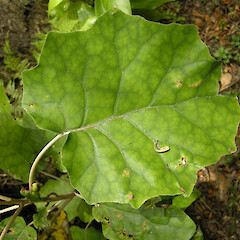Brachyglottis repanda
Common name
rangiora, bushman’s toilet paper, bushman’s friend
Synonyms
Cineraria repanda G.Forst., Senecio georgii Endl. Senecio forsteri Hook.f., Brachyglottis rangiora Buchanan, Brachyglottis rangiora Hort., Brachyglottis repanda var. fragrans D.G.Drury, Brachyglottis repanda J.R.Forst. et G.Forst. var. repanda
Family
Asteraceae
Flora category
Vascular – Native
Endemic taxon
Yes
Endemic genus
No
Endemic family
No
Structural class
Trees & Shrubs - Dicotyledons
NVS code
The National Vegetation Survey (NVS) Databank is a physical archive and electronic databank containing records of over 94,000 vegetation survey plots - including data from over 19,000 permanent plots. NVS maintains a standard set of species code abbreviations that correspond to standard scientific plant names from the Ngä Tipu o Aotearoa - New Zealand Plants database.
BRAREP
Chromosome number
2n = 60
Current conservation status
The conservation status of all known New Zealand vascular plant taxa at the rank of species and below were reassessed in 2017 using the New Zealand Threat Classification System (NZTCS) – more information about this can be found on the NZTCS website. This report includes a statistical summary and brief notes on changes since 2012 and replaces all previous NZTCS lists for vascular plants.
Please note, threat classifications are often suggested by authors when publications fall between NZTCS assessment periods – an interim threat classification status has not been assessed by the NZTCS panel.
- Conservation status of New Zealand indigenous vascular plants, 2017 . 2018. Peter J. de Lange, Jeremy R. Rolfe, John W. Barkla, Shannel P. Courtney, Paul D. Champion, Leon R. Perrie, Sarah M. Beadel, Kerry A. Ford, Ilse Breitwieser, Ines Schönberger, Rowan Hindmarsh-Walls, Peter B. Heenan and Kate Ladley. Department of Conservation. Source: NZTCS and licensed by DOC for reuse under the Creative Commons Attribution 4.0 International licence.
2017 | Not Threatened
Previous conservation statuses
2012 | Not Threatened
2009 | Not Threatened
2004 | Not Threatened
Brief description
Common large shrub or sometimes small tree with very large (5-15cm) thin mottled leaves with jagged edges and white underneath. New growth covered in tawny or white fuzz. Flowers small, white or cream, clustered into large conspicuous sprays.
Distribution
Endemic. North Island throughout. South Island - north west Nelson to just south of Greymouth in the west, and near Kekerengu in the east. Naturalised on Banks Peninsula, Otago Peninsula, and on Stewart Island at Oban.
Habitat
Common in coastal, lowland and lower montane shrubland and open forest. Often a pioneer species.
Detailed description
Shrub to small tree up to 6 m or more tall. Trunk one or more arising from ground, covered in somewhat corky bark. Branches stout, spreading, rather brittle, initially densely clad in fine white to buff tomentum becoming glabrescent with age. Petiole stout, grooved, 80-100 mm long. Leaves leathery, 50-250(-300) X 50-20(-30) mm, dark green to pale green above, undersides clad in fine, appressed vivid white hairs, broad- to ovate-oblong, obtuse to subacute, obliquely cordate to truncate at base, margins distantly dentately lobed to sinuate. Inflorescence a much branched panicle. Capitula 5 mm diam., numerous, without ligules (discoid). Involucral bracts 3 mm long, narrow-oblong to narrow spathulate, margins scarious except at base. Florets 10-12, yellow. Seeds (cypsela) narrowly oblong-elliptic to oblong elliptic, 1-1.8 mm long, ribs 6, rounded, broad. Pappus 2-3 mm, buff-yellow, scabrid.
Similar taxa
This shrub is unlikely to be confused with any other indigenous plant, except its close relative the Three Kings endemic B. arborescens. That species differs from B. repanda by its thick corky bark, smaller, saddle-shaped leaves, smaller, less branched panicles, darker sulphur yellow florets, oblong seeds 2-2.3 mm with 12-13 ribs, and longer pappus ((2.5-) 3.5-4.5 mm)).
Flowering
(July-) August-October (-November)
Flower colours
Cream, White
Fruiting
(October-) November-December (-January)
Life cycle
Pappate achenes are dispersed by wind (Thorsen et al., 2009).
Propagation technique
Very easy from fresh seed and from semi-hardwood or hardwood cuttings. Fast growing but inclined to be short-lived. benefits from a hard prune after flowering.
Etymology
brachyglottis: Name comes from the Greek words brachus meaning “short” and glottis meaning “the vocal apparatus of the larynx”
repanda: Means irregularly undulating or scalloped (describing leaf margins)
Where To Buy
Commonly grown and offered by many commericial nurseries and native plant specialist growers. Several variegated forms are now available, as is a purple-leaved cultivar cv. purpurea said to have come from a wild plant on the banks of the Wanganui River.
Cultural Use/Importance
The large leaves with their white, finely hairy undersides have served a dual purpose for many, as they make excellent toilet paper, and also can be written upon (with a ballpoint pen), thus allowing one to send rather novel letters.
Attribution
Fact sheet prepared by P.J. de Lange for NZPCN (1 June 2013)
References and further reading
Thorsen, M. J.; Dickinson, K. J. M.; Seddon, P. J. 2009. Seed dispersal systems in the New Zealand flora. Perspectives in Plant Ecology, Evolution and Systematics 2009 Vol. 11 No. 4 pp. 285-309
NZPCN Fact Sheet citation
Please cite as: de Lange, P.J. (Year at time of access): Brachyglottis repanda Fact Sheet (content continuously updated). New Zealand Plant Conservation Network. https://www.nzpcn.org.nz/flora/species/brachyglottis-repanda/ (Date website was queried)





















